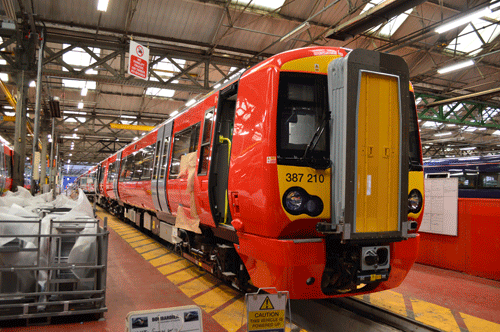The 501 new vehicles ordered for the Northern and TransPennine Express (TPE) franchises means that there are now more than 4,000 vehicles being built or on order for the UK.
And this is for the main line fleets - not the metro, where Transport for London is planning for the largest ever London Underground order and tram networks are expanding with new fleets being delivered.
It was November 27 last year - before the franchise orders were announced - that the Rail Delivery Group’s (RDG’s) new Chief Executive Paul Plummer highlighted how the industry is spending £9.3 billion on new trains and their maintenance contracts by the end of the decade.
Speaking at a rail industry gathering in Derby, Plummer said: “We know that fare payers want better trains, so this investment over the next four years is great news for our passengers. An average of 12 carriages per week are being built to meet demand - a far higher build rate than just a few years ago. More than half of the new trains are being built by British-based manufacturers, supporting more than 2,000 jobs including at least 100 apprenticeships.”
Of the fleets included in those figures, only three of the 11 ordered at that time were being delivered. It also did not include deals for new locomotives, for which six are due for GB Railfreight (Class 66s) and 25 for Direct Rail Services (Classes 68 and ‘88’).
Also not included were the additional vehicles for c2c, for which 17 four-car electric multiple units (EMUs) will be bought. Additionally, the Thameslink, Southern and Great Northern franchise (TSGN) appointed Siemens as preferred bidder for 150 carriages split across 25 trains (six-car trains) for its routes into Moorgate, to replace the ageing Class 313s that date from the electrification of Great Northern routes in 1976/77.
At the time Plummer spoke, at nearby Litchurch Lane Bombardier was completing the construction of the final Class 378 vehicles that would extend the London Overground electric multiple units from four to five-car trains.
The three fleets being delivered as Plummer spoke were the 108 Gatwick Express Class 387/2 vehicles, the 1,140 Class 700 vehicles for Govia Thameslink Railway and 866 Class 800/801 vehicles for Great Western Railway and Virgin Trains East Coast.
The latter two deals are the Thameslink and Intercity Express Programme (IEP) deals. Collectively these three deals are worth, including maintenance contracts, almost £7.5bn. All will be in traffic by the end of 2020 - indeed, this year the ‘387/2s’ and ‘700s’ will enter traffic while the first IEPs (or Super Express Train depending on the marketing) will enter traffic next year.
The new trains on order promise to transform the service quality of many routes, but many of the fleets they will replace are not destined for the scrapyard - instead they will go to other operators.
There is talk that some trains, such as the Class 442s, may end up in regions they have not been used in before as hauled stock, rather than powered EMUs.
But then there is also talk that some trains may also end up in fields, stored until a new home is found for them. Politically, the storage of trains at a time when capacity has become an issue is more of a hot potato than it was even a decade ago.
Some context is needed. At the start of privatisation, the railways were served by a mixed fleet. Diesel multiple units (DMUs) and EMUs had been delivered during the 1980s and 1990s as British Rail sought to move to a railway dominated by fixed formation trains. This trend continued in the privatisation era, when the need to replace the BR fleets from the 1950s and 1960s was needed. That meant that during the late-2000s, the railway had a young fleet but many of these types were reaching the halfway point of their careers.
The vehicles ordered that broke the infamous 1,064-day train order drought are now 17 years old (Class 168 Clubmans used by Chiltern Railways). The South West Trains Class 458s were the first electric trains delivered following privatisation, and these are now 17 years old. The c2c Class 357 and Southeastern Class 375 Electrostars date from 1999, while the Class 170 DMUs were first delivered to the Midland Main Line in 1998. Even Virgin Trains’ Class 390 Pendolino fleet first entered traffic in 2002, the same year that SWT’s Desiro fleet was launched.
These trains still seem new - and certainly compared with the Pacers used by Arriva Trains Wales (as well as in the North) and the EMUs operated by Merseyrail, they are - but they have been in use longer than some people realise.
This means that the average age of rolling stock nationally at the end of 2014-15 was 20.2 years, according to data released in October 2015 by the Office of Rail and Road (RAIL 787).
The average age of rolling stock fell across all sectors following the start of the time series, and nationally the average age of rolling stock fell 7.7 years between 2001-02 Q2 and 2005-06 Q2. The ORR says this was due to the rolling stock leasing companies (ROSCOs) replacing many of the BR fleets with new trains (2005 was the last year of Mk 1 slam-door trains on the former Southern Region, for example). After 2005-06 Q2 the average age of rolling stock increased for all sectors.
Nationally the average age of rolling stock has increased by 0.8 years between 2013-14 Q4 and 2014-15 Q4. This means newer rolling stock was introduced or older rolling stock removed from service during 2014-15. This was driven by newer rolling stock within the London and South East sector.
Following up Plummer’s quotes on November 27 last year, Rail Minister Claire Perry said: “Introducing more modern, high-quality trains is central to our commitment to give passengers better journeys and boost economic growth.
“We’re already making massive improvements through franchising - such as removing Pacer trains from the north of England with requirements for at least 120 new-build diesel vehicles, and introducing new trains on the East Coast, Great Western, and Thameslink lines.
“We are also pressing ahead with our plans for electrification, which will enable faster, greener electric trains to run on large parts of the UK’s rail network.”
Before the franchises were announced on December 9 2015 for Northern and TPE, the RDG said: “Several more large train orders are also expected in the coming years - with the new Northern, TransPennine, Merseyrail and East Anglia franchises all expected to procure new trains.”
Two of those four franchises have now been let, with new trains required. The exact details for the new fleets were under wraps as this issue of RAIL went to press, but it is known that in a £400 million programme, TPE winner FirstGroup is to acquire 220 new carriages (the equivalent of 44 five-car trains), and the company tells RAIL that it is ordering a mix of diesel, electric and bi-mode trains capable of 125mph to be introduced from 2017. As of mid-December, the company was in “advanced discussions” with a number of manufacturers. These trains will replace Siemens Class 185s, which date from 2006-2007, although the ‘185s’ will be retained to make up future South TransPennine trains in six-car formations - almost doubling capacity on that route.
Northern’s 281 new vehicles will be made up into 98 new train sets: 43 new electric trains (EMUs - a mixture of three-car and four-car) and 55 new diesel units (DMUs- a mixture of two-car and three-car).
Many of these trains will be capable of 100mph, and they will be the first brand new DMUs built for the UK mainland since the Class 172s in 2012 for London Midland and Chiltern Railways. The last DMUs built for the UK were actually built for Northern Ireland by Spanish train manufacturer CAF, the company responsible for the construction of the Heathrow Express Class 332 and Northern Rail Class 333 fleets, and which is also building the Mk 5s for Caledonian Sleeper.
Northern franchise winner Arriva says the overall fleet changes “are significantly more complex”, but the total number of carriages increases from 794 in April 2016 to 921 by December 2022, a 16% rise with the introduction of the new trains. Crucially for campaigners in the North, these new vehicles mean that the Class 14x trains are being withdrawn by the end of 2019.
TransPennine Express is no stranger to new trains. As well as the Class 185 DMU fleet (51 three-car trains), it is also home to ten four-car Class 350/4s delivered in 2013. Rumours persist that they will be cascaded away from TPE in due course, perhaps to London Midland where they will join Class 350/3s that were delivered at the same time as the TPE fleet. Nothing has been officially confirmed.
So what has been ordered and delivered in recent years?
Southern took delivery of Class 377s from Bombardier in 2013 and 2014, which enabled it to boost capacity on its Metro operations and also on the West London Line. Twenty-six five-car Class 377/6s (130 vehicles) ordered in 2011 were delivered less than 700 days later, entering traffic in September 2013 and enabling Southern to introduce more seats on heavily-loaded trains. These replaced two-car Class 456s that were transferred to SWT, which in turn was able to increase capacity with these smaller and older trains by adding them to four-car and eight-car formations on heavily-used routes.
Southern also introduced eight five-car trains (377701-377708) for its West London Line trains between East Croydon and Milton Keynes. These replaced four-car Class 377/2s, which were subsequently sub-leased to First Capital Connect (and now part of the TSGN franchise that also includes Southern) for Thameslink operation. Moving Electrostars to the Thameslink route enabled four-car Class 319s to be transferred to Northern Rail to operate on newly electrified railways.
Elsewhere in London, as mentioned earlier, London Overground (LO) introduced 57 new carriages onto its network by extending the Class 378 fleet from four to five-car formations. The final five vehicles were delivered to LO on December 2 (RAIL 790), and were ordered as part of the London Overground Capacity Improvement (LOCIP) and Rolling Stock Programmes (LOTRAIN) scheme.
This delivered five-car trains to the East London Line (ELL) by December last year and to the North London Line (NLL) by December 2015. The £88m deal was placed with Bombardier in May 2013, and was part of an option placed in the original order agreement that increases capacity on LO by 25%. The final five vehicles delivered were 38433/434/455-457. They will be inserted into 378233/234/255-257.
The first to be extended were 378135-154, which can only work on ELL or DC lines to Watford, while the ‘378/2s’ are capable of working on ELL, NLL, South London Line (SLL), West London Line (WLL) and DC Lines to Watford. This was not the first time some of the trains had been extended: 378001-378024 were delivered as three-car EMUs in 2009 with the plan always being to extend them to four-car trains, a move that was completed quickly.
Also in the capital, 29 four-car Class 387/1s (116 vehicles) were delivered to Govia Thameslink Railway (GTR) for the Thameslink route. The last entered traffic in May 2015 and also allowed GTR to cascade Class 319/3s to the North as well as four Class 319s to London Midland. The ‘387/1s’ will not be a long-term option for TL as they will be replaced by the Siemens Class 700s, and so will be transferred to GWR – although whether they will be used straightaway is open to conjecture at the moment due to the delays in electrifying the Great Western Main Line (GWML).
Locomotives are not included in the RDG figures. This means that Colas Rail’s 70801-70810, GB Railfreight’s (GBRF’s) purchase of 66752-66779 and Direct Rail Services’ Class 68 and 88 fleets are not included.
The Class 70s were ordered off the back of major National Supply Chain contract wins for Colas Rail, which has established itself as a significant player in the rail freight market. The haulage capability of the ‘70s’ means the company can bid for heavy haul work, and has been doing so.
GBRf has bought the final Class 66s that can be built for the UK, with delivery of the final batch from America due in early-2016. Any more that are needed (and GBRf has a history of expanding and importing ‘66s’ from Europe) will have to be second-hand.
As with all ‘66’ orders, they have been delivered in batches, with 66752-66756 the first to arrive on these shores in the summer of 2014, followed by 66757-66765 and then 66767-66772 at the end of last year. They will be joined by 66773-66779, bringing down the curtain on a design that first arrived here in 1998.
Since EWS 66001 arrived in April that year, a further 484 Class 66s have been delivered (although not all are in the UK) and following severe accidents, two have been scrapped (66521 following the Great Heck crash in February 2001, and 66734 after it went down a bank in the West Highlands in 2013).
DRS’ order of the Eurolight offered by Vossloh has enabled it to enter the passenger market while also offering powerful locomotives for freight work. So far 19 Class 68s have been delivered to the Cumbrian company. Of those 19, two are hired to ScotRail on a daily basis and six to Chiltern Railways for passenger work. It cannot be ruled out that more could be hired by operators in the future.
The real game-changer could be the Class 88. This is an electric locomotive fitted with a diesel engine. Similar in design to a Class 68, and also built by Vossloh, the Class 88s could prove invaluable in being able to operate ‘under the wires’ and also in terminals away from overhead line electrification. Network Rail is excited by the possibility, as is DRS, as you would expect. What it can offer the freight industry remains to be seen, but it could represent a significant evolution in operations.
There have been many changes in the last decade or so. Bi-mode is an option that offers greater flexibility for the likes of GWR, TPE and Virgin Trains East Coast. Greater capacity is being offered to operators in places it is needed, and even where new trains are not being delivered, cascaded trains are available to offer a step-change in service quality, as witnessed in the North West where trains operated by two-car Pacers have been transformed into four-car electric multiple units.
The next four years promises much in the train fleet market, with benefits to passengers and freight customers alike.
- This feature was published in RAIL 791 on January 6 2016















Login to comment
Comments
No comments have been made yet.